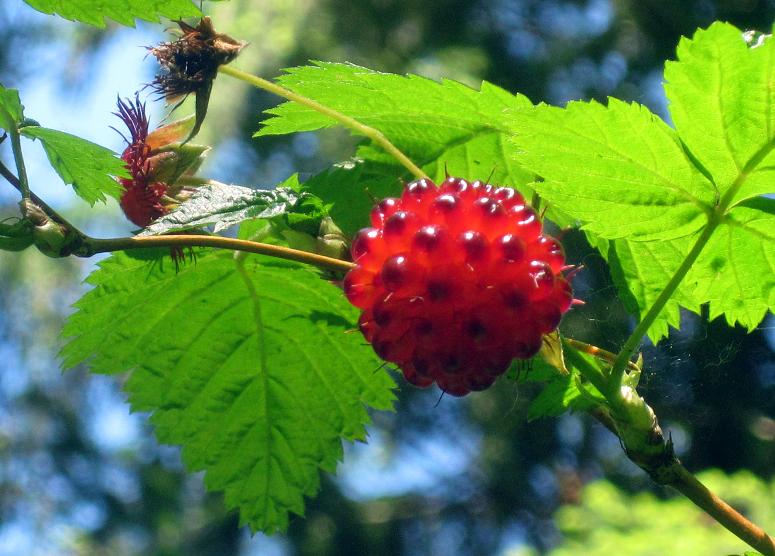 Summer breeze. Green leaves part. Glowing droplets of sunlight.
Summer breeze. Green leaves part. Glowing droplets of sunlight.
I was on my way home from work a couple days ago and I’d stopped to pick some Salmonberries. As I stretched up my go-go-gadget arms towards the gently swaying gems it occurred to me that I had no idea why they were called “Salmon”-berries. Was it the reddish colour? Kind of looks like salmon flesh, I guess. Early summer Sockeye runs are starting soon and the berries are ripening… Maybe that’s it. I wonder if they taste good with grilled salmon?
Then I noticed some of the berries had been really clumsily torn from their pedicels, or roughly smashed and left dangling from the stalk. As if someone with thick awkward fingers and long gnashing teeth had gone to work on ‘em. But that’s nuts, these bushes are massive. Whoever did it would have to be, like seven feet tall… And what’s with the smell?
Like a tanker passing close to shore, a massive black bear glided through the forest scrub thirty feet from where I stood… Whoa.
Wait, bears eat salmon, and they really seem to dig these berries. Maybe that’s why they’re called Salmonberries! What else do bears eat? Hmmmmm… It was definitely time for me to get on home.
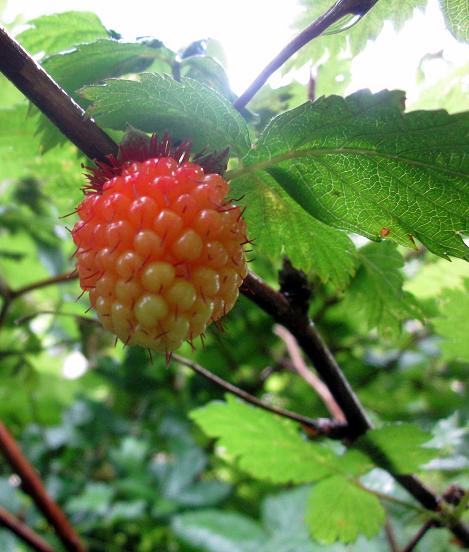 Safely back in my own kitchen, Crystal finally set me straight. They’re called “Salmonberries” because of their (now obvious) resemblance to salmon roe. Ikura! Of course! I use the stuff every day at work, and yeah, the tiny little ruby egg sacks really do look like the nubs on salmonberries. In fact, it was a common First Nations practice to actually mix the salmonberries with roe. The tart, acidic juices from the berries would slightly cure the eggs (no refrigeration back in the day) as well as add flavour. Genius!
Safely back in my own kitchen, Crystal finally set me straight. They’re called “Salmonberries” because of their (now obvious) resemblance to salmon roe. Ikura! Of course! I use the stuff every day at work, and yeah, the tiny little ruby egg sacks really do look like the nubs on salmonberries. In fact, it was a common First Nations practice to actually mix the salmonberries with roe. The tart, acidic juices from the berries would slightly cure the eggs (no refrigeration back in the day) as well as add flavour. Genius!
Salmonberries are the first of the berries that I refer to as the “Three Sisters” to emerge during the spring, and ripen during the early summer, the other two being thimbleberries and blackberries.
They tend to grow in thickets that run alongside footpaths, over culverts, and frequently skirt ditches – So be careful when you’re reaching for that last hard-to-reach berry, you might go for a tumble! For some reason they really like the company of alder trees, and will gather under them in greater numbers than under firs. This could be linked to the levels of intermittent light/shade they get from standing under deciduous trees, or some characteristic that alder roots give the soil… Or maybe they’re just good friends. I ‘dunno.
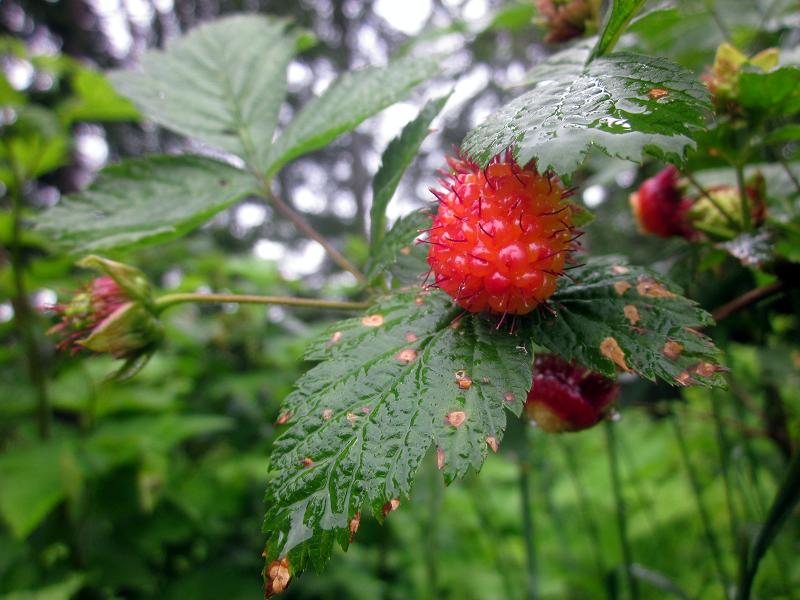 The young spring shoots can be picked, stripped of their rough brown skin and eaten out of hand. Lisa showed us how to do this back when we were picking nettles in April, and man they were good! They have a mild sweet-tart flavour reminiscent of rhubarb or sour watermelon candies. Once past their edible infancy, these plants will grow to between five and a towering eight feet tall!
The young spring shoots can be picked, stripped of their rough brown skin and eaten out of hand. Lisa showed us how to do this back when we were picking nettles in April, and man they were good! They have a mild sweet-tart flavour reminiscent of rhubarb or sour watermelon candies. Once past their edible infancy, these plants will grow to between five and a towering eight feet tall!
Unlike her sisters, the salmonberry bush is supported by long thin perennial stalks that go from green to rusty brown. These, along with their height, bright pink flowers and distinctively serrated green leaves makes ’em pretty easy to spot from a distance. Also unlike the other species, the actual berries that the salmonberry bush produces come in a couple different colours. Some produce berries that will ripen to a deep red, some will stay a bright post-it-note yellow, and some will settle in between with a sunset orange hue. It all depends on the individual bush that you are picking from, so mix it up. The berries ripen in early June and will continue to produce all month long. Check back every couple days and your bushes will reward you with more love.
Some of the orange and yellow berries look like underipe red ones, so it’s a little hard to tell which ones to pick. I’ve found the best way is to attune yourself to the berry’s inner darkness:
A perfect berry can be easily identified by it’s size, slightly softened texture and the dark, almost obsidian sheen that slowly creeps into the drupelets (nubs!) as they ripen. Regardless of the base colour of the berry, once that dark glow (it’s an oxymoron, I know, but it’s the only way I can explain it) takes hold, it’s begging to be eaten! Attune yourself to the dark side young Jedi.
What you will need to Forage for Salmonberries
- Container – A bag or plastic container with a seal-able lid is ideal for storing your berries.
- Stool – I consider myself a pretty tall guy, but I’m often I’m on my tippy toes to reach these berries. Short people might need some assistance.
- Anti-Bear Gear – My little encounter is all too common out here on the Westcoast. The bears are foraging just like you, and sometimes wander close to trails and backyards. Make lots of noise, carry bear-bells, mace if necessary and you will be fine. Just don’t leave your headphones on too loud. Bears are like ninjas.
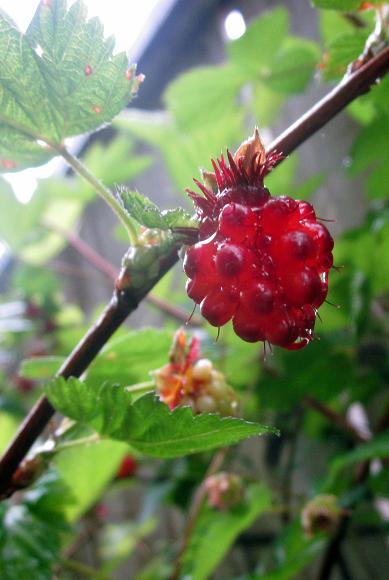 Salmonberries may look soft, but they are surprisingly tough and keep their shape even under the roughest of picking conditions. You aren’t going to be staining your shirt either, because the salmonberry has a comparatively lower amount juice than blackberries or thimbleberries. Most of the berry’s mass is taken up by the seeds inside each drupelet, which find a way to hide in every nook and cranny of your teeth by the way. A lot of recipes call for straining the seeds out of the flavour-filled flesh and juices. I wholeheartedly agree!
Salmonberries may look soft, but they are surprisingly tough and keep their shape even under the roughest of picking conditions. You aren’t going to be staining your shirt either, because the salmonberry has a comparatively lower amount juice than blackberries or thimbleberries. Most of the berry’s mass is taken up by the seeds inside each drupelet, which find a way to hide in every nook and cranny of your teeth by the way. A lot of recipes call for straining the seeds out of the flavour-filled flesh and juices. I wholeheartedly agree!
The taste of salmonberries is a little hard to pin down. They are sour, but not overpoweringly sour, and with a light floral-sweet finish that lingers long enough to keep your face from screwing up reflexively. It’s a beautiful balance, and one that is only present in the completely ripe ones. There are also hints of orange peel, spices and wild herbs that you may not find in other berries. Mmmmm… Rustic.
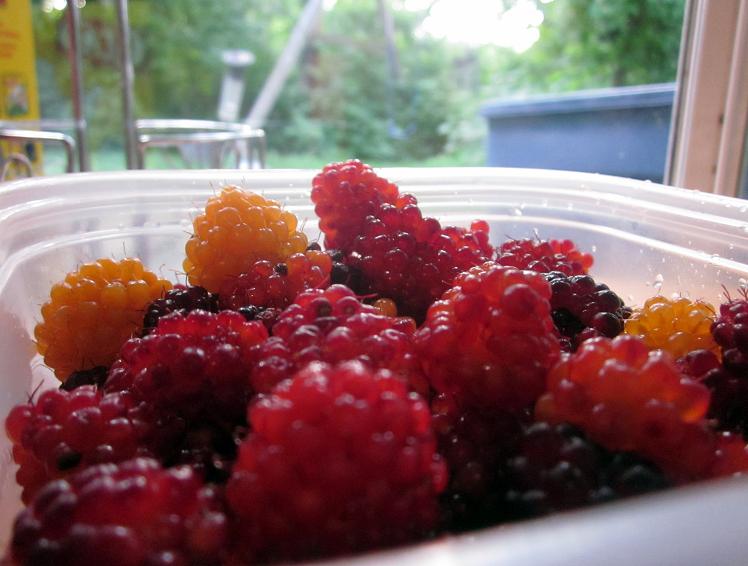 A snap comparison in taste is gooseberries, but though salmonberries share their tart, tannic zing, they are subtly sweeter and have a more nuanced flavour. Raspberries are another close comparison, but this time the salmonberries come out less complex and more acidic. I mentioned rhubarb already, but that’s pretty far afield. In the end, I guess salmonberries taste most like salmonberries.
A snap comparison in taste is gooseberries, but though salmonberries share their tart, tannic zing, they are subtly sweeter and have a more nuanced flavour. Raspberries are another close comparison, but this time the salmonberries come out less complex and more acidic. I mentioned rhubarb already, but that’s pretty far afield. In the end, I guess salmonberries taste most like salmonberries.
Salmonberries are usually made in jams, or preserves, baked into pies and tarts, or just rendered down to give syrups a little kick. My favourite recipe so far is the awesomely-named Bear Poop Pie from the Wild Salmon Kitchen Blog. On the savoury side, they are often paired with game birds (especially quails and Cornish hens) and of course, salmon. C’mon, salmon with salmonberries… No chef could resist putting that on a menu. It’s quirky! I’ve heard of people making salmonberry wine as well… I wonder how that ends up.
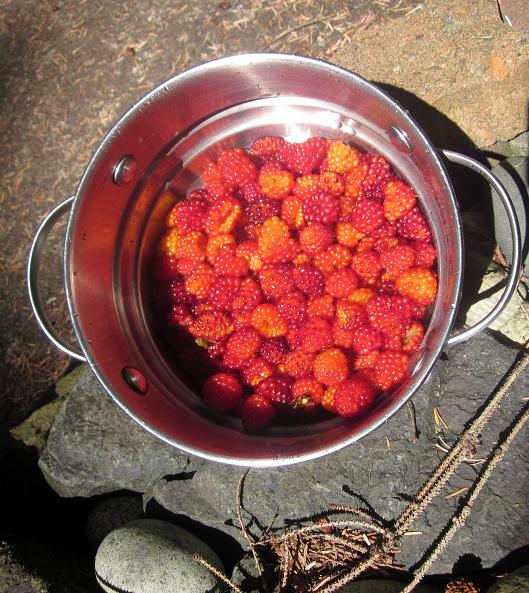 I’ve got a bunch of berries that I picked yesterday and I’ve given them a good wash and picking over to remove any bugs and bits. In my next post I’ll cook ‘em up in a way that’s sweet and summery.
I’ve got a bunch of berries that I picked yesterday and I’ve given them a good wash and picking over to remove any bugs and bits. In my next post I’ll cook ‘em up in a way that’s sweet and summery.
So yeah, Get out into that scrub, commune with nature, pick some berries and eat them right there on the spot! They taste the best that way.
Oh, and watch out for bears.
For more Salmonberry ‘lovin check out this brilliantly written essay on Salmonberries and Northwest culture at the Saudade Blog:
http://brianfink.wordpress.com/2012/06/08/salmonberries-pacific-northwest-cuisine-an-essay/
Salmonberries are the best! They taste very good, and your berries are different from ours 🙂
Hitchhiking along the Oregon coastal Hwy. 1 in the late 1960s, there was a salmonberry thicket along the road. They were delicious. Unfortunately, they are not native to Ohio.
I think they are called salmonberries because the First Nations of BC traditionally eat them with salmon.
Bears definitely enjoy salmonberries so be alert if picking them as one person put it, they are ninja like in our property it was easy for a 600lb animal to arrive in the garden over fine twigs etc without being heard, I knew when they were about as my tethered dog would let me know by his barking. one strange thing is he would stand up and eat our plums but always lay down when eating an apple